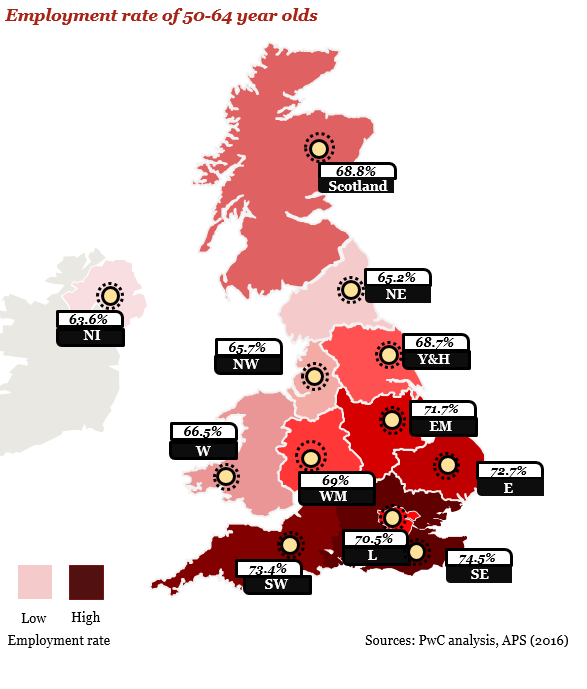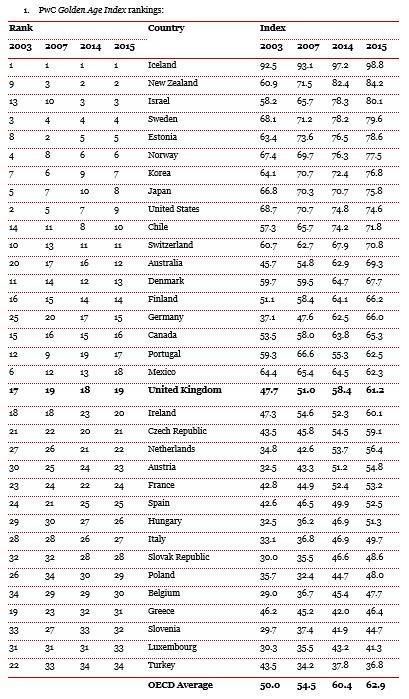June 20, 2017
Extending the length of working lives could boost UK GDP by £80 billion 0
 The UK could boost its GDP by around 4.2 percent (around £80 billion at today’s values) if the employment rate of workers aged over 55 could match that of Sweden, the highest performing EU country, according to a new PwC analysis comparing the employment of older workers across 34 OECD countries. There is a 12 percentage point gap between the employment rates of workers aged 55-64 in the UK and Sweden. PwC’s Golden Age Index is a weighted average of indicators – including employment, earnings and training – that reflect the labour market impact of workers aged over 55. The UK has remained middling in the rankings since 2003, falling by one place from 18th in 2014 from 19th in 2015. The report suggests that extending working lives could have a transformational effect on the economy.
The UK could boost its GDP by around 4.2 percent (around £80 billion at today’s values) if the employment rate of workers aged over 55 could match that of Sweden, the highest performing EU country, according to a new PwC analysis comparing the employment of older workers across 34 OECD countries. There is a 12 percentage point gap between the employment rates of workers aged 55-64 in the UK and Sweden. PwC’s Golden Age Index is a weighted average of indicators – including employment, earnings and training – that reflect the labour market impact of workers aged over 55. The UK has remained middling in the rankings since 2003, falling by one place from 18th in 2014 from 19th in 2015. The report suggests that extending working lives could have a transformational effect on the economy.
Across the UK, the South East of England has the highest employment rate of older workers aged 50-65 at 74.5 percent, compared to a UK average of 70.0 percent. Northern Ireland has the lowest employment rate for older workers at 63.6 percent, compared to 66.5 percent for Wales, 68.8 percent for Scotland and 70.6 percent for England. PwC has found regional differences in employment rates of older UK workers appear to hinge on three key factors: economic performance, educational attainment and gender disparities.
 John Hawksworth, PwC’s chief economist, commented: “While the UK’s absolute performance on our Golden Age Index has improved over time, it’s still scoring below the OECD average. As the number of people over 55 continues to grow steadily and life expectancy increases, the UK needs to make it as easy as possible for people to continue working for longer if they wish to do so. This would boost both GDP and tax revenues, so helping to pay for the increased health, social care and pension costs of an ageing population. Looking at employment rates for older workers across the UK reveals the areas that need the most focus, as well as symptoms of poor performance. Regions with fewer older workers with university degrees and a larger gap between male and female employment tend to have the lowest employment rates for older workers.”
John Hawksworth, PwC’s chief economist, commented: “While the UK’s absolute performance on our Golden Age Index has improved over time, it’s still scoring below the OECD average. As the number of people over 55 continues to grow steadily and life expectancy increases, the UK needs to make it as easy as possible for people to continue working for longer if they wish to do so. This would boost both GDP and tax revenues, so helping to pay for the increased health, social care and pension costs of an ageing population. Looking at employment rates for older workers across the UK reveals the areas that need the most focus, as well as symptoms of poor performance. Regions with fewer older workers with university degrees and a larger gap between male and female employment tend to have the lowest employment rates for older workers.”
Across the UK older female workers have a lower employment rate than their male counterparts at 64.9 percent for 50-64 year olds compared to 75.4 percent for males. The gender pay gap also increases with age, from an average of £28 per week for 22-29 year olds to £153 for 50-59 year olds. PwC analysis suggests the labour market experience of older women is often characterised by lower pay, more part-time work and higher barriers to entry than males, driven by work-life patterns and occupational segregation.
 PwC has found a higher educational background is also associated with working later into old age. More qualified older workers may be better able to adapt to technological changes, while the industries in which more qualified workers are employed could be better suited to working in later life.
PwC has found a higher educational background is also associated with working later into old age. More qualified older workers may be better able to adapt to technological changes, while the industries in which more qualified workers are employed could be better suited to working in later life.
John Hawksworth added: “Reforming pension systems and providing financial incentives to encourage later retirement will be key to governments increasing the number of older workers. Measures to combat age discrimination and support lifetime learning in the face of rapid digital and technological progress are also required. The call by the government’s business champion for older workers, Andy Briggs, for employers to increase the number of older people in the UK workforce by one million over the next five years is a step in the right direction, but more needs to be done.”
Iceland remains number one in PwC’s Golden Age Index, a position it has held since 2003. Nordic neighbours Sweden and Norway also continue to do well with places in the top 10. Turkey maintains its position at the bottom of the index, having fallen 12 places since 2003.
Israel has gained 10 places in the rankings since 2003, up from 13th place to 3rd, while Mexico has fallen from 6th place in 2003 to 18th place today.
Across the OECD as a whole, PwC estimates the potential long-term GDP gain from raising employment rates for the over 55s to match Swedish levels could be around $2 trillion. Potential gains could rise as high as 16 percent of GDP for Greece and 13 percent for Belgium. For the US, they could be around 3 percent of GDP, or around 2 percent of GDP for Japan.




















